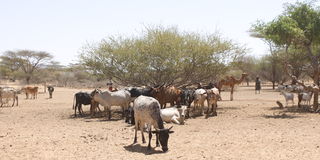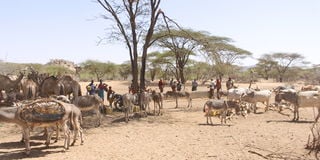Why number of cattle is diminishing in the North

Cattle at Nairabala watering point in Laisamis, Marsabit County on February 8, 2022. The number of cattle in Marsabit is on the decline due to climate change and perennial drought.
At the end of last year, Mr Solomon Lenaropi, a resident of Nairabala in Laisamis, Marsabit County, was the proud owner of 10 cows that provided his family with milk.
By February, he had only four – survivors of the brutal drought.
Mr Lenaropi, the Nairabala community chairman, has in the past year witnessed neighbours and fellow herders lose hundreds of cattle to drought.
Being in charge of a community watering point where herders pay Sh20 per herd to access water, he has witnessed the number of cattle coming to drink decline on every visit.
The dwindling number of cattle among communities in Marsabit County has now caught the attention of policymakers as more herders opt for more resilient animals like camels and goats.
“Very soon, I will be left without cattle if the drought persists. One time, a herder comes to water 10 cattle but the next round, only five are alive. Cattle are succumbing to drought in high numbers,” he said.
“There are now more goats and camels coming to drink. Milk has become rare. We may soon be left without cattle in the community,” Mr Lenaropi said.
Without pasture and having to walk long distances in search of water, cattle succumb faster than other animals.
“The drought has been recurring over the years and keeps killing our cattle. More than 60 percent of cattle in this village have died,” he said.
While cattle have been one of the most important farm animals in parts of Northern Kenya, climate change is threatening their existence.
The difficulties of raising cattle when rainfall is scarce have seen some pastoralists across these regions shift focus and adopt camel husbandry in the last few years.
Data from the county government indicates that by June 2021, there were 266,340 cattle, 1,208,750 goats, 1,052,440 sheep, 280,520 camels and 96,560 poultry.
However, in February 2022, there were 186,440 cattle, 1,214,790 goats, 1,062,460 sheep, and 281,930 camels and 97,600 poultry.
Current scientific evidence indicates that climate variability is now threatening reliance on cattle.
According to Marsabit County National Drought Management Authority (NDMA) Coordinator Henry Mustafa, cattle husbandry is alarmingly on the decline in the county.
“The changes in climatic conditions have continuously led to the decline in the number of cattle reared in the county. Most of the herders are opting for camel husbandry as a resilience-building modality,” Mr Mustafa said.

Livestock at Nairabala watering point in Laisamis, Marsabit County. While cattle have been among the most important farm animals in parts of Northern Kenya, climate change is threatening their existence.
He noted that nearly all the pastoral communities that preferred cattle are now ready to let go of them in favour of the camel.
In the past 30 years, more cows have been dying due to droughts and flash floods thus necessitating a paradigm shift among the pastoralists.
For instance, the drought of 2005 to 2006 led to a 70 percent fall in the size of pastoralists' livestock herds in Northern Kenya.
The 2021 to 2022 drought has killed more than 224,000 livestock.
The 2019 livestock census reported that Marsabit County had 240,700 cattle, 1,143,480 goats, 744,500 sheep, 627,835 camels, 63,861 donkeys and 26,100 poultry.
Also Read: Locals flee village due to water shortage
The population of livestock by June 2021 in Marsabit County was 266,340 cattle, 1,208,750 goats, 1,052,440 sheep, 280,520 camels and 96,560 poultry.
The latest animal population of February 2022 in the county was reported to be 186,440 cattle, 1,214,790 goats, 1,062,460 sheep, 281,930 camels and 97,600 poultry.
Marsabit County Livestock director Moses Lengarite also affirmed that cattle numbers were on the decline.
According to the 2015 Livestock census, Marsabit County had 424,603 cattle, 1,143,480 goats, 960,004 sheep, 203,320 camels, 63,861 donkeys and 50,690 chickens.
The number of cattle has, however, drastically declined to less than 200,000 following their massive deaths and sales by the herders in exchange for camels.
The camel’ population currently stands at over 250,000 in Marsabit County.
Mr Lengarite said that the county lost over 30 percent of cattle to the ongoing drought.
“The value of camels is now becoming increasingly acknowledged by the pastoralist communities, policymakers and researchers since climate variability has become a big challenge,” Mr Lengarite said.
He added that most rich people have also shifted their focus on camel husbandry due to the huge returns involved.
An adult camel fetches between Sh60,000 to Sh70,000 which is double the price of cattle in the livestock markets.
“They now prefer camels to cattle due to their resilience amidst natural calamities like droughts, famine, diseases and flash floods hitting the region,” Mr Lengarite said.
The pastoralists are also learning to diversify their livestock by rearing cattle, camels, goats and sheep.
“The diversity of the herds ensures risk distribution. For instance, small stocks -- goats and sheep -- have high fertility and hardiness to drought. This makes them suitable for helping herders recover from the impacts of drought,” he said.
Mr Mustafa notes that the post-drought restocking of cattle is costly and counterproductive, making the government and various agencies prefer sheep and goats.
Camels are browsers since they have a varied diet which includes shrubs and trees, increasing their survival rates during drought.
It is also estimated that camels produce six times more milk than what is produced by an indigenous cow.
Camel production is a major source of livelihood for the pastoralists in the arid and semi-arid lands (Asals) of Kenya, which hosts six percent (1.06 million) of the African camel population.





